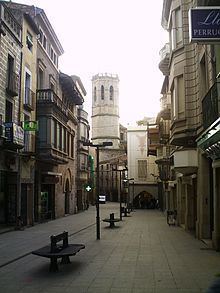Country Spain Time zone CET (UTC+1) Elevation 373 m Local time Monday 9:37 PM | Postal code 25300 Website www.tarrega.cat Area 88.4 km² Population 16,587 (2014) Comarca Urgell | |
 | ||
Weather 9°C, Wind E at 5 km/h, 88% Humidity | ||
Tàrrega (Spanish: Tárrega) is a village and municipality located in the Urgell comarca, Province of Lleida, Catalonia. According to the 2009 census (INE), the village has a population of 16,539.
Contents
Map of 25300 T%C3%A0rrega, Lleida, Spain
Tàrrega is the capital of Urgell in the Ondara River basin. The village has a Mediterranean/continental climate, with an average temperature of 14 °C, and an average rainfall of 451 mm per year according to the Meteorological Service of Catalonia. Local attractions include a park at Sant Eloi mountain (420 m) with a Romanesque church of the 13th century. Its theatre fair, held annually each September, attracts over 100,000 people a year.
History
Tàrrega's growth began in the 11th century, when Count Ramon Berenguer I conquered its castle. Located at a strategic crossroad, medieval Tàrrega became an important economic and territorial possession. Indications of the town's vitality at the time include its Jewish community, its fairs and markets, and its large amount of artisans (especially goldsmiths). This period of prosperity was ended by the Black Death, which depopulated the town. Construction of Tàrrega's walls began to monopolize its resources, spurred by the fear of feudal violence. From the 16th to the 19th centuries, Tàrrega began to take on a more rural character, controlled by rich local families. A series of wars in the region caused instability in the city, as well as three revolts of Carlists.
In the second half of 19th century, Tàrrega underwent a revival. Important events in this time included the inauguration of a railway line connecting the town with Manresa and Lleida in 1860, reconstruction of the walls after a flood in 1874, and the granting of the title of city by King Alfonso XII in 1884. This period also saw the establishment of modern infrastructure in the city.
Geography
The city of Tàrrega is arranged around the square of Carme, better known as "the Courtyard" (Catalan: el Pati). The square features a statue of the classical composer Ramon Carnicer, a famous Tàrrega resident. Adjacent to the square is the Convent of Carme, a Renaissance cloister which dates to the 16th century. Notable buildings in the town square include the town council building, built in 1674, as well as the 19th century modernist chamber of commerce building and the 1910 La Caixa savings bank.
Other local landmarks include the museum on the main street, which still preserves some noble rooms from the 18th and 19th centuries, and the church of Saint Anthony (Catalan: Sant Antoni) in the square of the same name, which dates back to the 14th century. Higher up are the ruins of the castle of Count Ramon Berenguer, constructed in 1056. Little remains of the castle.
The municipality includes the villages of El Talladell, Claravalls, Altet, Santa Maria de Montmagastrell, La Figuerosa, Riudevelles, and Conill (abandoned).
